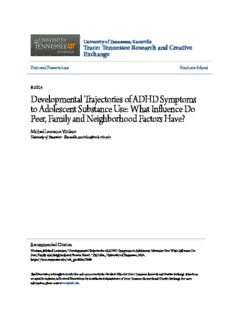
Developmental Trajectories of ADHD Symptoms to Adolescent Substance Use PDF
Preview Developmental Trajectories of ADHD Symptoms to Adolescent Substance Use
UUnniivveerrssiittyy ooff TTeennnneesssseeee,, KKnnooxxvviillllee TTRRAACCEE:: TTeennnneesssseeee RReesseeaarrcchh aanndd CCrreeaattiivvee EExxcchhaannggee Doctoral Dissertations Graduate School 8-2014 DDeevveellooppmmeennttaall TTrraajjeeccttoorriieess ooff AADDHHDD SSyymmppttoommss ttoo AAddoolleesscceenntt SSuubbssttaannccee UUssee:: WWhhaatt IInnflfluueennccee DDoo PPeeeerr,, FFaammiillyy aanndd NNeeiigghhbboorrhhoooodd FFaaccttoorrss HHaavvee?? Michael Lawrence Vitulano University of Tennessee - Knoxville, [email protected] Follow this and additional works at: https://trace.tennessee.edu/utk_graddiss Part of the Child Psychology Commons, and the Clinical Psychology Commons RReeccoommmmeennddeedd CCiittaattiioonn Vitulano, Michael Lawrence, "Developmental Trajectories of ADHD Symptoms to Adolescent Substance Use: What Influence Do Peer, Family and Neighborhood Factors Have?. " PhD diss., University of Tennessee, 2014. https://trace.tennessee.edu/utk_graddiss/2869 This Dissertation is brought to you for free and open access by the Graduate School at TRACE: Tennessee Research and Creative Exchange. It has been accepted for inclusion in Doctoral Dissertations by an authorized administrator of TRACE: Tennessee Research and Creative Exchange. For more information, please contact [email protected]. To the Graduate Council: I am submitting herewith a dissertation written by Michael Lawrence Vitulano entitled "Developmental Trajectories of ADHD Symptoms to Adolescent Substance Use: What Influence Do Peer, Family and Neighborhood Factors Have?." I have examined the final electronic copy of this dissertation for form and content and recommend that it be accepted in partial fulfillment of the requirements for the degree of Doctor of Philosophy, with a major in Psychology. Derek Hopko, Major Professor We have read this dissertation and recommend its acceptance: Paula Fite, Greg Stuart, Irfan Asif Accepted for the Council: Carolyn R. Hodges Vice Provost and Dean of the Graduate School (Original signatures are on file with official student records.) Developmental Trajectories of ADHD Symptoms to Adolescent Substance Use: What Influence Do Peer, Family and Neighborhood Factors Have? A Dissertation Presented for the Doctor of Philosophy Degree The University of Tennessee, Knoxville Michael Lawrence Vitulano August 2014 ii Copyright © 2013 All rights Reserved iii Dedication To my family, especially my father and mother for their overwhelming support and belief in me through all of my academic endeavors. iv Acknowledgements What a long strange trip it has been. I am grateful for the mentorship and professional guidance of Paula Fite, who took a chance in giving me this wonderful opportunity many years ago. I appreciate your patience and thoughtful teaching of research methods and statistical analysis. I would also like to acknowledge Derek Hopko for his continued mentorship and sharing his knowledge in research methods and scale development. This project would also not have been possible without the gracious provision of data and resources from John Lochman at The University of Alabama and Karen Wells at Duke University. v Abstract Attention-Deficit/Hyperactivity Disorder (ADHD) has been consistently linked to risk for early substance use. However, the potential mediating mechanisms and moderators of this association remain unclear. The current study examined peer rejection, school bonding and internalizing problems as potential mediators of the association between childhood ADHD symptoms and adolescent substance use in a longitudinal study following children from fourth to ninth grade. Results suggest that ADHD symptoms follow a path to early initiation of tobacco use through the combined effects of peer rejection and internalizing problems as well as through internalizing problems alone. ADHD symptoms did not follow developmental pathways to overall frequency of substance use or initiation of alcohol or marijuana use. Neighborhood problems, family activities and parenting styles did not moderate the developmental pathways from ADHD symptoms to substance use frequency. Results identify important development factors in children with ADHD symptoms that highlight the need for primary prevention and psychological interventions that target these factors and thus minimize substance use during adolescence. vi Table of Contents Section 1: Introduction 1 ADHD and Associated Impairments 2 ADHD and Substance Use 3 School Bonding as a Potential Mediator 4 Internalizing Symptoms as a Potential Mediator 6 Neighborhood, Parenting, Family Activities and Substance Use 8 The Current Study 9 Section 2: Method 11 Participants 11 Procedures 12 Measures 13 Substance Use 13 ADHD Symptoms 14 Peer Rejection 14 School Bonding 15 Internalizing Symptoms 15 Aggressive Behavior 15 Parenting 16 Neighborhood Quality 16 Family Activities 17 Section 3: Data Analytic Plan 17 Section 4: Results 19 Descriptive Statistics 19 Path Model 21 Moderators of Path Model 22 Survival Analysis 22 Tobacco 22 Alcohol 24 Marijuana 24 Moderation of Survival Analysis 25 Section 5: Discussion 25 ADHD to Substance Use Frequency 25 ADHD and Initiation of Substance Use 26 Implications for Intervention 29 Limitations and Conclusion 29 References 32 Appendix 51 Table 1 52 Figure 1 53 Figure 2a 54 Figure 2b 55 Vita 56 vii List of Tables Table 1. Correlations, Means and Standard Deviations 52 viii List of Figures Figure 1. Developmental trajectories from childhood ADHD symptoms to adolescent substance use path model. 53 Figure 2a. Risk for tobacco use initiation from fourth grade to ninth grade through internalizing symptoms 54 Figure 2b. Risk for tobacco use initiation from fourth grade to ninth grade through peer rejection and internalizing symptoms. 55
Description: